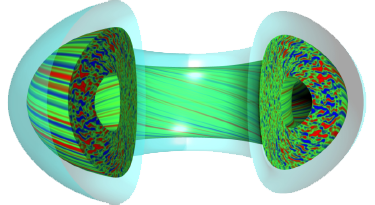Bayesian inference provides the ideal framework for modelling complex systems made of multiple heterogeneous measurements. Independent generative models of plasma diagnostic measurements can be implemented in a modular way and used to carry out Bayesian inference within a single consistent Bayesian model which relates few common plasma parameters to different kinds of observations....
In tokamaks, most diagnostics systems have a relatively small aperture, which limits the availability of only line-integrated measurements. The measurement represents line-integrated emissivity through the approximated line-of-sights (LOS), determined by pin-hole positions. By combining line-integrated measurements, tomography can reconstruct the two-dimensional (2D) distributions of physical...
It is reported about the prior analysis in design and tomography analysis of soft X-ray (SXR) diagnostic on Keda Torus eXperiment (KTX). The tomographic KTX aims at studying three dimensional effect in reversed field pinch with high plasma current, particularly in quasi-single-helicity (QSH) states. In order to reflect the experimental constraints and QSH configuration, the Bayesian...
Recent progress in harnessing novel machine learning (ML) / artificial intelligence (AI) algorithms to enhance EFIT equilibrium reconstruction for fusion data analysis and real-time applications is presented. This includes development of a ML-enhanced Bayesian framework to automate and maximize information from measurements and Model-Order-Reduction (MOR)-based ML models to efficiently guide...
Infrared (IR) thermography system is a key diagnostic in fusion devices to monitor the Plasma Facing Components. Nevertheless, both the qualitative and quantitative analysis (i.e. the hot spot detection and the surface temperature measurement) are challenging due to the presence of disturbance phenomena as variable emissivity and multiple reflections in fully metallic environment. To do so, a...
The measuring conditions in Magnetic Confinement Fusion (MCF) devices are complex. Original diagnostic data of interferometer systems could be unreliable due to electromagnetic interference, mechanical vibration, and hardware failures. Obtaining accurate density profiles, which are reconstructed without the influence of incorrect data, are beneficial to the reliable feedback control of density...
Recently, an advanced plasma current tomography has been constructed on EAST, which combines Bayesian probability theory and neural networks. It is different from the previous current tomography using CAR prior. Here, CAR prior is replaced with Advanced Squared Exponential kernel function (ASE) prior. It can solve the deficiencies on CAR prior, where the calculated core current is lower than...
Causality is a crucial aspect of human understanding and therefore one would expect that it would play a major role in science and particularly in statistical inference. On the contrary, traditional statistical and machine learning tools cannot distinguish between correlation and causality. This lack of discrimination capability can have catastrophic consequences for both understanding and...
The next generation of Tokamaks and the future reactor will be operated relying much more on feedback control than present day machines. The control of macroscopic instabilities, such as Sawteeth and ELMs, will be essential. In this perspective, various pacing experiments have been indeed successfully carried out in many devices in the framework of scenario optimisation. Unfortunately, many...
In fusion devices, as in many other experiments, time series are the typical form of the signals produced by the measuring systems. The detection of causality between time series is therefore of great interest, since it can give a unique contribution to the understanding, modelling, and prediction of phenomena still not fully understood. However, detecting and quantifying the causal influence...
In many fields of the natural sciences, from biology to physics, information tools are acquiring more and more importance. For the analysis of information transfer between time series in particular, the use of the transfer entropy is spreading. A typical application is synchronization experiments, which involve coupled quantities, a “target” and a “source”, with quasi-periodic behaviours. On...
Plasma filaments – or blobs – are large, coherent structures in the Scrape-Off-Layer (SOL) of fusion devices which can significantly contribute to heat and particle transport out of the plasma. Electric probe arrangements are a standard tool for investigating plasma filaments in the SOL of magnetic fusion experiments. In the Wendelstein 7-X (W7-X) stellarator, recent work has characterized...
Over the last years, Bayesian Analysis became a standard method in plasma physics for a common plasma parameter profile determination and mathematical correct error analysis [1-3], evaluating data measured by various diagnostics.
This paper gives an overview of established as well as recently deployed physics models within the Minerva Bayesian analysis framework [2] for a wide range of...
When preparing the operation of a magnetic confinement fusion device, estimating the heat-load distribution on plasma-facing components expected during operation presents a critical issue. Due to the relevance of this problem, most magnetic confinement fusion laboratories can be expected to develop their own device-specific approaches to predict this heat-load distribution.
This...
Reflectometry will be used in ITER to measure the electron density profile and to provide key information of the density fluctuations. There are two reflectometry systems, one at the high magnetic field side (HFS) and one at the low field side (LFS).
The synthetic diagnostic (SD) for both reflectometry systems is being developed, with a goal of modelling the reflected signals for ITER...

